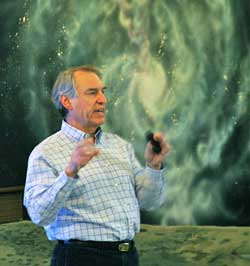|
A shoestring experiment may have discovered a new force of nature.
For nearly a century, physicists believed every interaction in nature was driven by one of four fundamental forces:
• Gravity pulls massive objects together and keeps us on the ground.
• Electromagnetism powers our homes and factories, and lights up the sky in thunderstorms.
• The Strong force holds protons and neutrons together, making the core of the atoms in everything we see.
• The Weak force
allows particles to morph from one type into another, enabling the
creation of essential elements, including carbon, oxygen, and iron.
Now, there
are hints of a new force, perhaps a dark force controlling the dark
side and dominating the universe — very Darth Vader-ish.
If
confirmed by more research, this will be the greatest surprise and the
most important discovery in particle physics in 40 years.
And
the best part of the story is that this discovery uses technology that
was state-of-the-art 60 years ago — its beam energy is 5 million times
less than the LHC (Large Hadronic Collider), and the experiment cost
about 10,000 times less.
Hungarian
physicists, lead by Attila Krasznahorkay, report finding a new
fundamental boson that is produced 200,000 times less often than normal
bosons. As yet unnamed, I’ll call it Attila.
All
fundamental bosons, except Higgs, are force carriers. For example,
photons (the particles of light) carry the electromagnetic force between
charged particles — electrons repel other electrons by exchanging
photons. Protons attract neutrons by exchanging other bosons.
By extension, theoretical physicists Tim Tait and colleagues at UC Irving propose that Attila
carries a new force. Its feeble interaction with normal matter means
this fifth force might answer the biggest mystery in physics: what is
dark matter?
Two
caveats. Firstly, Attila’s group has previously announced discoveries
that were never confirmed. Secondly, many public reports say Tait has
“confirmed” Attila’s discovery — that is incorrect. Theorists can
explain what observations mean, but in science, observations of nature
can only be confirmed by more observations. Math can help us model nature, but nature is not constrained by our equations.
We will have to wait several more years for more experiments and more answers.
I’ll end with technical highlights of Krasznahorkay’s and Tait’s research papers. Like all other force-carrying bosons, Attila has spin 1. It has zero charge and mass 16.7 MeV. It decays to electron e– / antielectron e+
pairs, with a lifetime of roughly 0.01 trillionths of a second. In the
micro-world, that’s a long time. This means its mass width is only 0.06
eV, making it extremely hard to produce in colliding beam machines —
impossible if one didn’t know where to look.
The key evidence for Attila is the excess e– / e+ pair production shown below (bars above the curve, to the left of “x4”).

The
excess is greatest along curve (b) at a proton beam of energy 1.10 MeV,
with less excess along curve (c) at 1.04 MeV, and no significant excess
at 1.20 or 0.80 MeV.
Protons
incident on a Lithium-7 target produce the 18.15 MeV excited state of
Beryllium-8. This decays to its ground state by emitting a gamma ray
most of the time, but rarely (about 5.8 times per million), it emits Attila instead.
The e– / e+ angle is 180º in Attila’s rest frame; it peaks at 140º in the lab frame.
Tait suggests Attila interacts with electrons and neutrons, but not with protons, thus making it even more elusive.
Best Regards,
Robert

Sept 6, 2016
Note: Previous newsletters can be found on my website.
|